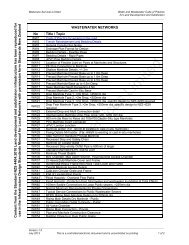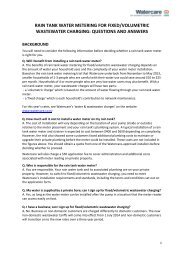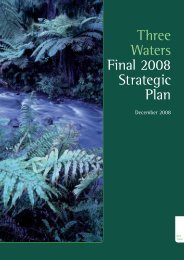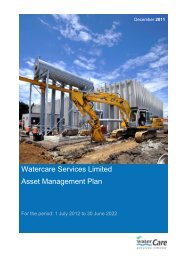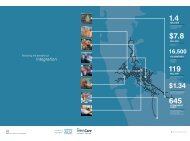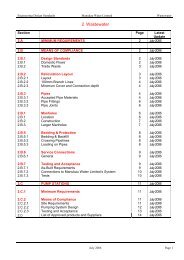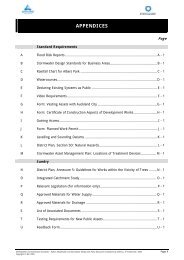Annual Report 2011 - Watercare
Annual Report 2011 - Watercare
Annual Report 2011 - Watercare
You also want an ePaper? Increase the reach of your titles
YUMPU automatically turns print PDFs into web optimized ePapers that Google loves.
<strong>Watercare</strong> Services Limited<br />
<strong>2011</strong> ANNUAL REPORT<br />
Notes to the financial statements (continued)<br />
for the year ended 30 June <strong>2011</strong><br />
21. Financial Assets and Liabilities (continued)<br />
Loans and receivables<br />
Due to their relatively short-term nature, the carrying amount of trade receivables is considered a reasonable approximation of fair value.<br />
Amortised cost<br />
Due to their relatively short-term nature, the carrying amount of trade payables is considered a reasonable approximation of fair value.<br />
The fair value of loans and borrowings is calculated based on the present value of contractual principal and interest cash flows, discounted<br />
at the market rate of interest in the reporting period.<br />
Fair value through profit and loss<br />
Interest rate swaps are measured at the present value of future cash flows estimated and discounted based on the applicable yield curves<br />
derived from quoted interest rates and the forward foreign exchange contracts are measured using observable market forward exchange rates.<br />
Fair value hierarchy<br />
The fair value hierarchy groups financial assets and liabilities into three levels as explained below based on the significance of inputs used<br />
in measuring the fair value of the financial assets and liabilities.<br />
Level 1: Quoted prices (unadjusted) in active markets for identical assets or liabilities;<br />
Level 2: Inputs other than quoted prices included within level 1 that are observable for the asset or liability, either directly (i.e. as prices)<br />
or indirectly (i.e. derived from prices); and<br />
Level 3: Inputs for the asset or liability that are not based on observable market data (unobservable inputs).<br />
The level in which the financial asset or liability is classified is determined based on the lowest level of significant input to the fair<br />
value measurement.<br />
The only financial assets and financial liabilities that are measured at fair value in the statement of financial position are derivative financial<br />
instruments. The valuation for derivative financial instruments is based on level 2 fair value hierarchy. The derivative financial instruments that<br />
the group holds at balance date comprise of interest rate swaps and forward foreign exchange contracts.<br />
Fair values at balance date have been assessed using a range of market interest rates between 2.68% and 5.35% (2010: 3.13% and 5.34 %),<br />
derived from the interest rate swap curve.<br />
There have been no transfers between levels 1, 2 and 3 during the year ended 30 June <strong>2011</strong>.<br />
Financial instrument risks<br />
Risk management objectives and policies<br />
The group’s management monitors and manages the financial risks relating to the operations of the group through internal risk reports which<br />
analyse exposures by degree and magnitude of risks. The main types of risks are market risk, credit risk and liquidity risk.<br />
The group seeks to manage the effects of these risks by using derivative financial instruments to minimise these risk exposures. The use of<br />
financial derivatives is governed by the group’s policies approved by the Board of Directors, which provide written principles on interest rate risk,<br />
credit risk, the use of derivative and non-derivative financial instruments, and the investment of excess liquidity. Compliance with policies and<br />
exposure limits is reviewed by the Board of Directors on a regular basis.<br />
Market risk<br />
The group is exposed to market risk through its use of financial instruments and specifically to interest rate, foreign currency and certain other<br />
price risks. The group manages its market risk by regularly assessing the impact of changes in the market interest rates and foreign currency rates<br />
on the group’s portfolio.<br />
<strong>2011</strong> Financial <strong>Report</strong><br />
Interest rate risk<br />
Interest rate risk is the risk that the fair value or future cash flows of a financial instrument will fluctuate because of changes in market interest<br />
rates. The group is exposed to interest rate risk when it borrows funds at floating interest rates. The risk is managed by the group through<br />
monitoring market interest rates and reviewing the impact of these on interest rate exposure.<br />
The group has a mixture of borrowings with both fixed rates and floating rates of interest. It is group policy to ensure that a proportion of interest<br />
rate exposure is maintained on a fixed-rate basis. To achieve this, the group enters into contracts that allow some of its floating interest rate<br />
exposure to be swapped from floating to fixed, and vice versa. The contracts are called interest rate swaps and interest rate options.<br />
The group’s exposure to market interest rates relates primarily to the group’s debt obligations which are disclosed in note 20, page 95.<br />
The group regularly analyses its interest rate exposure. Within this analysis, consideration is given to potential renewals of existing positions,<br />
alternative financing, alternative protective positions and the mix of fixed and variable interest rates.<br />
PAGE 98<br />
Return to Contents page





